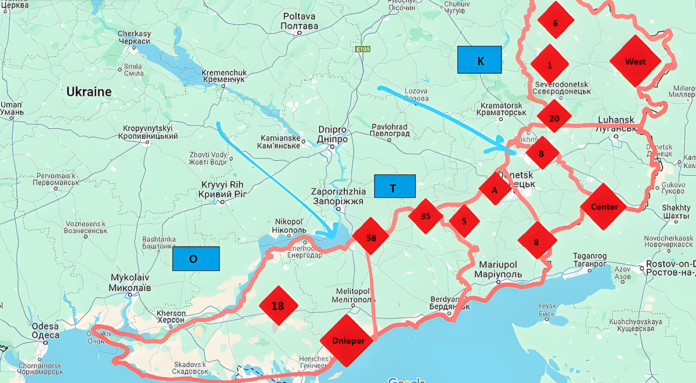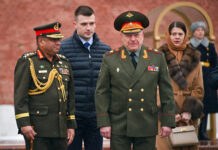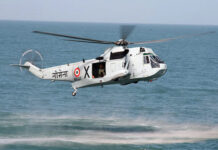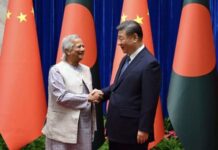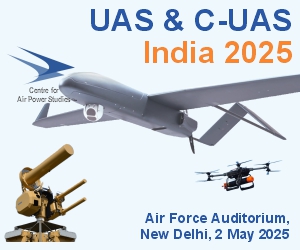Ukraine is a different issue. It is intimately connected to the Slavic culture and is the birthplace of the Russian Civilization. In this article, we shall refrain from delving into this topic. Instead, our focus will be on more relevant content. Throughout the 20th century, Ukrainian insurgencies have posed challenges for Moscow, causing significant disruptions and friction in the relationship between Ukraine and Russia. The Ukrainians have scrambled for self-determination throughout the pre and post-Soviet years, leading to various insurgencies and revolts such as the Ukrainian War of Independence in 1917-1921, the Holodomor famine-genocide in the 1930s, Ukrainian nationalist movements during World War II, post-1991 crises and the Euromaidan protests. These insurgencies have been a source of contention and instability for Moscow.
Russia’s Strategy
Russia’s approach to war planning, particularly concerning the ongoing conflict with Ukraine, has often been misinterpreted. The Russian strategy exhibits remarkable tactical prowess, maturity, and calculated decision-making. By drawing Ukraine into a prolonged state of attrition, Russia aims to exhaust Ukrainian resources while incrementally advancing its positions. This accumulative push allows Russia to secure territorial gains and serves a strategic purpose by creating a buffer zone and gaining leverage in negotiations. Additionally, Russia’s strategy of gradual advance serves to root out the potential for insurgency within the territories it seeks to control. By consolidating their positions methodically, Moscow aims to preemptively address any potential resistance or insurgency from local populations, which helps maintain control over the newly acquired territories with the priority of stabilizing the regions under Russian control.
The Russian strategy evolved over the early course of the operation, which was intended to reign in the Ukrainian regime out of its NATO ambitions and the ethnocultural cleansing of the Donbas region, but not to occupy or annex Ukrainian territory per se. But as the narrative from Western countries became more entrenched with hostility and delusional opportunism to use Ukraine to degrade Russia permanently, the Russian strategy shifted to the gradual bleeding and destruction of Ukrainian military capabilities, including its projection of power and threat.
Hence, fundamentally, Russia has never completely aimed at capturing Ukrainian territory in a grand scenario. Russia also knew that such a strategy would be militarily frivolous in terms of tactical, operational, and strategic goals. However, it was also not in its long-term political interests and was fraught with significant risks. Russia is not fighting the war the Soviet Union had during WWII. Neither is Russia the Soviet Union, nor are the historical contexts or exigencies under which it operates similar to or necessitates conducting itself based on what might have been relevant almost eighty years ago! Russia also never had the military manpower at the outset of the Special Military Operation or even today to roam across Ukraine. And it has to preserve a significant portion of its forces to protect itself from potential ongoing aggression from NATO and its multiple allies close to Russian territory.
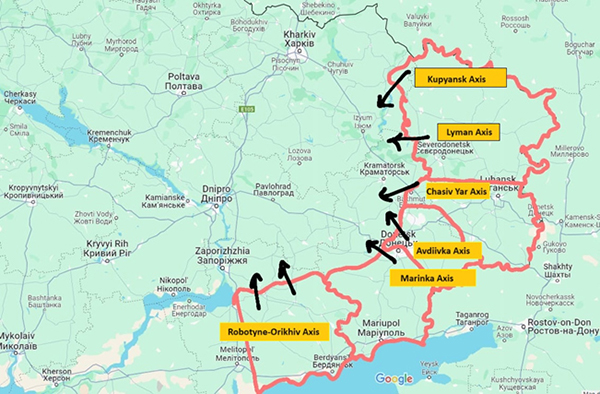
Ukrainian Forces
Ukraine’s force structure is always difficult to understand because of its tendency to form ad hoc battlegroups and its practice of fragmenting forces into resident brigade commands. In fact, ORBAT and force distribution in Ukraine are in a league of their own. As a result, the AFU’s organization and force generation are often more opaque and difficult to understand than Russia’s, for example. Whereas Russia uses conventional army-level groups, Ukraine has no organic commands over the brigade level. The chains of higher command of the Armed Forces of Ukraine (AFU) are extraordinarily flexible and irregular entities. Ukraine’s entire fighting organization is an improvised mixture and modification around established formations. That aspect applies especially to its highest field commands down to the brigade level. The AFU field command system’s most conspicuous anomaly is its absence of any division-level (and higher) formations. Ukraine started abolishing the Division around a decade ago in a forced restructuring.
The German Kampfgruppe units during WWII were used as a contingency against front disarray, severe losses, and replacements. They were ad-hoc combat units formed during World War II by the German Army, often composed of infantry, armor, and supporting elements for specialized tasks or missions. The AFU idealization of all-level Kampfgruppen is bizarrely unique. That said, the primary picture is one of three Ukrainian “Operational Strategic Groupings,” vaguely akin to army groups. These are, from north to south, Operation Strategic Groupings (OSGs) in Khortytsia, Tavriya, and Odessa. Against these are arrayed four Russian Army Groups – from north to south: Army Groups West, Center, East, and Dnieper. Assessing the total line strength is always tricky, largely because we do not always have good insight into the actual combat rating of these units. However, we can make estimates of paper strength. Based on deployment information from the Project Owl Ukraine Control Map, we can estimate that the nominal strength in the theater right now is some 33 Division Equivalents for Ukraine against perhaps 50 DEs for Russia – a significant, but not utterly overwhelming Russian advantage. Ukrainian Army-level formations are absent because they simply do not exist, and such arrangements prove to be a pressing challenge for any formal military establishment.
War Doctrine
But, as the Operation evolved, Russia rather quickly devised a strategy of destroying Ukraine’s Military and, by extension, degrading its NATO sponsors through long-term attrition, where the territorial battles have been used as opportunities to demolish Ukrainian forces little by little, as death by a thousand cuts over an extended period and across a vastly stretched battlefield where killing the enemy and destroying its equipment is the primary goal no matter how limited the amount of territory actually gained.
As far as Russia’s War Doctrine in Ukraine is concerned, Russia is committed to positional attrition warfare as this maximizes the asymmetry of their advantage. This depletes the firepower of not only the Ukrainian Armed Forces but also of NATO members without engaging in direct conflict with them. Russian Armed Forces iron out Ukrainian defenses with artillery and then push forward into pulverized defenses. As Ukraine continues to funnel units to refill positions, they play into the hands of the Russian Military. Noting the importance of deploying fresh operational reserves as a crucial element of any counterattack, Russia keeps the burn rate at the front high. It degrades Ukraine’s ability to form reserves and continues to place immense pressure on Ukraine and NATO, not solely in terms of seizing territory but in terms of attrition, chipping away infrastructure, and creating a cumulative impact on Ukraine’s overall fighting capability. Kiev’s position is untenable as they may be able to fight effective static defense from prepared positions. Still, they cannot reverse Russian gains or respond to new breakthroughs without a combined arms reserve. Any serious effort by Ukraine to retrieve the fortified cities will divert the scarce trained manpower and equipment, thus squashing any attempts of offensive campaigns. They are also currently exhausted to the point where they lack combat-effective combined arms reserve units. Furthermore, such units have been unable to maneuver efficiently due to fuel shortages and incessant Russian artillery and air strikes.
Russia’s Advances
Russia is slowly advancing on almost every axis of the theater, which has both strategic and tactical implications, as the Ukrainians are being forced to burn reserves while being prevented from rotating and reconstituting their forces, as well as a precise operational formulation. Russia’s maneuver scheme must be kept in mind regarding its minimum end-state objectives: to capture the remaining Donbas city agglomerations (around Slovyansk) around Kramatorsk Although the war and Russia’s military ambitions may not end there.
At present, there are several main axes of advancement: On the central axis of the front, the Russian thrusts on the Avdiivka axis and the Chasiv Yar axis converge on the crucial Ukrainian hub of Konstytinivka, capturing which is a prerequisite for any serious effort to advance on Kramatorsk.
Simultaneously, Russian forces exert ongoing pressure on the northern front, employing a gradual squeeze tactic on the city of Kupyansk at the apex of the Oskil line and advancing towards Lyman along the Zherebets axis. These maneuvers aim to establish a foothold towards the strategic objective of Kramatorsk, contingent upon Russian control of the north bank of the Donets River up to the Izyum confluence with the Oskil.
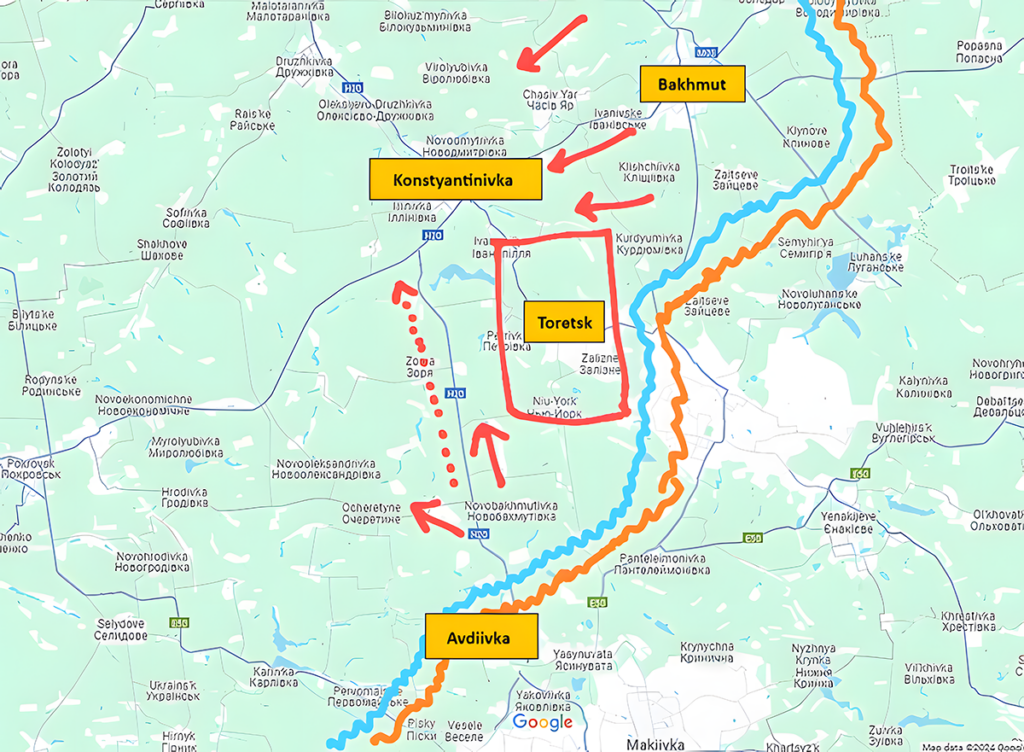
In the southern sectors, Russia expands its zone of influence following the capture of Marinka, likely intending to build momentum towards Kurakhove, thereby placing the Ukrainian stronghold of Ugledar in a precarious position. Ugledar’s proximity to Russian rail lines vital for the land bridge amplifies its strategic significance, prompting Russian efforts to seize it. Additionally, Russian forces target the Ukrainian-held Robotyne salient, a remnant of Ukraine’s counteroffensive. While these assaults serve to tie down Ukrainian forces, they also aim to preempt any Ukrainian aspirations to utilize Robotyne as a launching point for future offensives towards Tokmak. Thus, these southern operations serve both attritional purposes and the strategic neutralization of Ukrainian staging areas. The overarching operational scenario indicates Moscow is gaining offensive momentum across the entire theater. This trend undermines Ukrainian combat effectiveness by impeding rotation, regeneration, and lateral troop movements while depleting Ukraine’s already limited reserves.
Sustaining the War Effort
The Russo-Ukrainian War is one of industrial attrition – a grueling campaign marked by relentless assaults against entrenched defenses, where concrete, steel, and explosives dictate the tempo. Ukraine confronts a stark reality: Russia’s military buildup nears critical mass, tipping the scales decidedly in Moscow’s favor. Initially strengthened by a substantial shell inventory, Ukraine’s arsenal benefitted from meticulous resource management and international aid, notably from the United States and South Korea. However, sustained high-intensity combat depleted much of these reserves, leaving Ukrainian forces grappling with a critical shortage of artillery ammunition.
Ukraine has sought to expand its production capabilities to sustain its war effort, primarily in Europe and the United States. Yet, this strategy encounters formidable obstacles: sluggish industrial ramp-up, production targets insufficient to match Russia’s onslaught, and logistical hurdles such as barrel scarcity. The United States has fared better in ramping production, slated to deliver approximately 500000 shells in 2024. Europe faces various problems, like labor shortages, exorbitant energy costs, and a consensus-driven decision-making culture that is slow to allocate significant resources. The European practice of small orders placed by individual member states also makes manufacturers hesitant to invest significantly in new production lines. Or, as one Belgian general put it: “We’re in deep shit.”
Ukraine’s ammunition shortfall remains dire even if the USA and Europe meet their delivery targets. Optimistically, combined efforts might yield 1.3 million rounds annually, equating to a modest daily allocation-insufficient for sustained offensive operations. Ukrainian Defense Minister Reznikov’s assertion of needing nearly 12000 shells daily underscores the magnitude of the challenge. While this figure may be aspirational, conservative estimates suggest Ukraine requires at least 200000 shells monthly to maintain a functional military posture. However, with current projections, Ukraine faces an uphill battle in amassing the requisite stockpile for intensified offensives. Artillery barrels deteriorate with prolonged use, typically lasting around 2500 shots for a howitzer. Consequently, assuming sustained firing rates as desired by Reznikov, Ukraine would face the wearing out of approximately 125-150 guns per month. Complicating matters further, Ukraine operates at least 17 different artillery platforms. Meanwhile, Russia’s shell production capacity has been significantly underestimated. Domestic Russian production has surged, with Estonian estimates indicating around 3.5 million shells produced in 2023, which is expected to increase to 4.5 million in 2024. Russia has considerable capability to sustain a firing rate of up to 12000 shells per day, with reserve surge capacity. Even if European production surges as anticipated, there remains a substantial advantage for Russia, potentially reaching a ratio of 3-1 or even 5-1 in artillery firepower. This advantage is compounded by Western reports of increased Russian production of advanced strike systems such as cruise missiles, Geran drones, Lancets, and glide bombs, boasting greater power and range. Recent publications, such as those from the Royal United Services Institute, highlight Russia’s capacity to deliver significant numbers of tanks, armored vehicles, and missiles, further solidifying its military dominance.
The most important question is simple: whether an army’s relative combat power is growing or shrinking over time – that is, whether its ability to generate forces is greater than its rate of burn – can it reconstitute attrited units in a timely manner, generate replacements, recover, repair, and replace broken equipment, and so forth. The prototypical example of this is, of course, the German-Soviet War. Even though the Third Reich enjoyed favorable “loss ratios” throughout most of the war, the ratio of combat power consistently grew in the USSR’s favor due to their vastly superior force generation powers. During the Battle of Kursk, Hitler even quipped that the loss ratios should predict an imminent German victory. Loss ratios do not matter nearly as much as the relative rate of loss and force generation. Estonian intelligence estimates underscore Russia’s ability to continually train, equip, and deploy additional troops, outpacing current loss rates. RUSI further emphasizes the growth in Russian forces deployed in Ukraine, from 360000 to 470000 over the last year, highlighting the formidable challenge Ukraine faces. Russian force generation continues to grow steadily over time rather than merely replenishing losses.
In contrast, Ukrainian forces face increasing manpower shortages, with under-strength brigades tasked with increasingly demanding operations. It’s evident that Ukrainian reserves are dwindling, as highlighted in Avdiivka, where brigades from other fronts were hastily deployed, indicating a lack of strategic reserves. The elite 3rd Assault Brigade was even committed in the final stages of the battle to stem the tide. Meanwhile, units like the 110th Mechanized engaged for months, suffered significant attrition due to the inability to rotate out. In contrast, Russia conducts regular troop rotations while Ukrainian forces remain on the front lines due to a shortage of replacements.
The Minister of Defence of the Russian Federation, Sergei Shoigu recently made an uncharacteristically bold statement that the AFU was committing much of its remaining reserves: “After the collapse of the counteroffensive, the Ukrainian Army command has been trying to stabilize the situation at the expense of the remaining reserves and prevent the collapse of the frontline.”
What to Expect?
In the near term, one could expect Russia to progress toward the following intermediate operational goals:
• Developing a concentric offensive towards the Ukrainian agglomerations around Chasiv Yar, Novomikhailovka and Toretsk
• An offensive along the Zherebets-Oskil line towards Lyman to capture or screen the Donetsk River line as a prerequisite for an operation against Kramatorsk
• Continued assaults towards Kurakhove in preparation for the liquidation of the Ugledar salient
• Preventative attacks towards the Orakhiv axis to prevent future Ukrainian attempts to exploit the Robotyne salient
While 2022 witnessed initial successes for Ukraine, 2023 saw missed opportunities despite ample Western assistance. Instead, Ukraine exhausted valuable resources in defending Bakhmut and futilely attacked a well-prepared Russian defense in the south. With Russian force generation rising inexorably, Ukraine faces the looming threat of strategic defeat. To avert this, Ukraine must pursue a radical mobilization plan bolstered by increased support from its allies. However, Ukraine lacks the capacity to train and equip its forces independently. Without substantial NATO assistance, a total mobilization risks escalating casualties without significant gains. Yet, even maintaining current levels of aid is challenging amidst waning international support and domestic crises in crucial NATO member states.
2022 was the year of wild swings as the front stabilized into a conveniently shaped and quickly supplied Russian position, and 2023 was the year of Ukraine’s strategic window of opportunity, frittered away at Bakhmut. 2024 is the year that Russia’s swelling force generation reaches a climax, and the war turns in an evident and irreversible way against Ukraine. As Steve Harris of Iron Maiden remarked in one of the most iconic songs of the band, “The sands of time for me are running low…”, Kiev has almost no time and resources to ‘orchestrate’ (special courtesy Wagner PMC) any meaningful offensive operations. Of course, once substantially degraded, the Ukrainian regime and its allies would be at Russia’s mercy in shaping the postwar era in Ukraine, both politically and territorially. The Russo-Ukrainian conflict has demonstrated that industry, manufacturing & the physical economy have always been relevant, and newly emerging powers such as India must grasp this insight to develop a broadly industrialized economy in the wake of a real two-front threat and a rewarding prospect of becoming a serious global power. That said, the window of strategic opportunity has closed for Ukraine and now opens wide for Russia. In this sense, one must appreciate how a few meters in this theatre equals hundreds of miles relative to the grand old wars of the previous century. The heinous attack at the Crocus City Hall marks the beginning of a new phase in the conflict. March 2024. Not very far from Fontainebleau, a windy dawn at Brussels unfolds skies seven and a half decades old. The sun struggles to pierce through the misty haze, and the approaching summer months carry the weight of a hot war.


